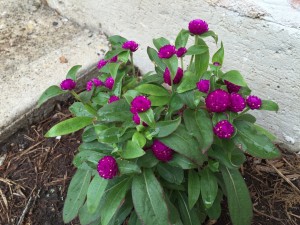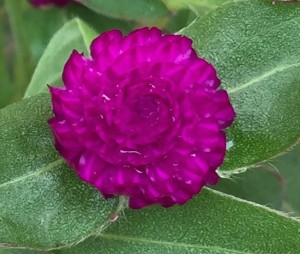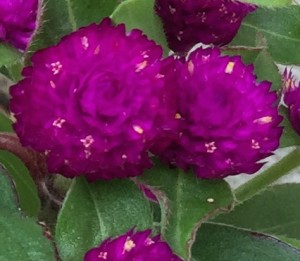Gomphrena is a favorite summer flower. I ran into them at the plant store, and they brought back memories. So, I bought a few for a hot strip of soil to the side of the drive. With the Texas summer fast approaching, not much will likely grow there in the heat; but my experience with gomphrena is that they can take the heat and keep on blooming. It is hot today, and this gomphrena plant looks like it is enjoying the sun and warmth.
Up close, gomphrena globules are almost molten purple.
These pretty spheres are a deception. That’s right. What look like purple petals are not blooms at all? They are magenta bracts. A “bract” is a modified or specialized leaf. Now, don’t take my words at face value. Look beyond me at the face of these older globes from a nearby plant and form your own opinion.
See those yellow-white specs? Those are tiny trumpets. If you look real close, you can sort of see them. Those small trumpets are the true flowers of the shy gomphrena.
“Why?” you ask.
Although the gomphrena originated in Central and South America, on the hillsides and among the trees from Guatemala to Panama to Brazil, the plant is now a global citizen. From Portugal to Nepal to Japan to Hawaii and back home again to Latin America, the globes and their hidden flowers have assumed names in the languages of the world. There is no hiding these trumpets from their fans.
So, why are they so small and who are they hiding from?
Far back in the beginning of time in the primeval forests of long ago, there lived the Gomph. The Gomph was a dreadful creature of great strength with a special fondness for a particular plant, when it wasn’t gomphing around the forest after the animals and peoples, making life generally miserable for everyone in those far-back ancient times. Well, the plant the Gomph loved to munch more than anyone or anyotherthing was the sweet yellow trumpet, a large white-yellow flower with tiny leaves. Through many years of Gomph salad breaks, the only trumpets left were small greenish plants with reddish leaves and tiny trumpets. And still, the Gomph munched and munched and terrified the neighborhood between trips to the salad bar. Until, all the trumpet flowers were gone, depleted, ingested and nowhere to be seen easily or found readily. The Gomph was not amused. He searched and searched and sighted some tiny yellowish trumpets hidden in the magenta leaves of some stunted and dwarfed plants that had grown through his repeated onslaughts. Sniffing, they smelled similarly. Why not? The Gomph gulped a great mouthful of the purplish blooms and let out a terrible screech, jumping and kicking, gagging and spitting, round and around in a circle of distress. The flowers were simply terrible to eat. So terrible, that the great Gomph kicked up his heels, raced from the woods and was never seen again. The native peoples visited the patch and with glee on their faces and jumps in their steps, they twirled and spun, singing, “Phrena, Phrenabeanah, Hoppiedoodlepaahs Gomph-Phrena!!!!!!” which everyone knows in the ancient languages of Guatemala-Panama-Brazil means, “Free, Free at last, Hooray for the Gomph-phrena plant.” You see they had in their joy named the plant for the wonder it had wrought. In a crowd, they gathered around and touched and admired the purple globes with the tiny trumpets and vowed to plant forever the flowers around their villages and to spread the Gomphrena to the ends of the earth.
And, they did.
And, that may not be exactly how it happened.
But, it certainly does explain a tiny trumpet surrounded by purple leaves.
And, it does seem to explain why you do not see those leaves on salads.
And, why you do not see that Gomph anymore.
Now, do you?
Phrena
Phrenabeanah
Hoppiedoodlepaahs
Gomph-Phrena!!!!!!!!!!!!!!!
Grandpa Jim



